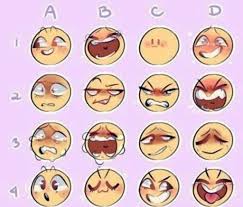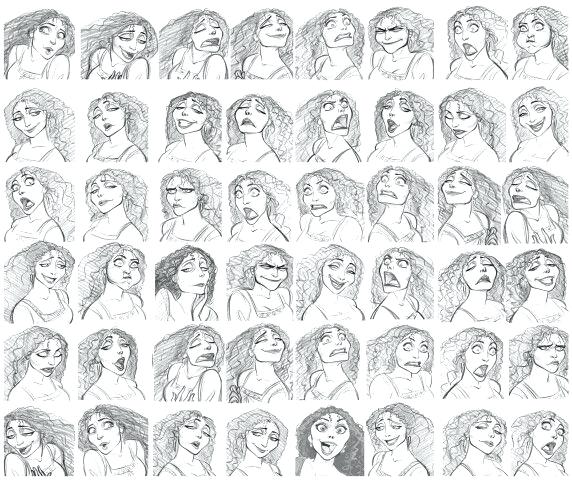How to make subtle expressions on characters?
-
Hi, My Name is Jaycen.
First time on here so hope I'm doing this right.
My question is how to make subtle expression. On characters I see a lot of emotion charts. To help draw expression on characters, But they are always extreme, And at times very cartoony. I'm hoping to find a chart, a place. Or Better reference material.
I'm still learning to draw figures, And my hope is to one day make a comic, And use subtle expressions to both make it a bit more realistic, And to save the wild, over expressive faces for extreme or dramatic scene.
And wile I'm learning I wish to practice the subtle expressions in face, And body.
(Here are some chart I normally find on google.)


So can someone please answer this for me. Or tell me if what I looking for is wrong, And I should practice these extreme postures?
-
I have very little experience on drawing characters esp. people and facial expressions but I too have seen many charts like this. And I think at first it might be adventageous to learn the big emotions and the extremes - how the facial muscles function, expressive lines and shapes and then once you practise and understand maybe work backwards or lessen the intensity.
Also you can physically try out on your own face, you can feel memory or mirror work what the more subtle facial lines and shapes might look like. My friend told me she did this for understanding how to draw a girls body - her own lols.
Anyways I hope these tin bits might help, that’s how I may eventually go about it.
-
@Jaycen Hi Jaycen!
Okay so there are three things to know about this.First, your examples are very stylized characters. The more cartoony, the more extreme the expressions will be. Subtler expression will work better on more realistic characters. On very stylized characters, it'll mostly just look blank or unexpressive.
The second thing is more complex. We humans can detect a large range of emotions in real life, but in a drawing that scope is always diminished. A lot of the cues we distinguish in real life are so subtle that it only works o n a real living person. Sometimes it's so small that we need to be able to see the before and after (in real life or video) to even notice the shift. That cannot be captured in a photo and even less a drawing. Moreover so many of these signs are completely subconscious that duplicating them consciously is very difficult if not impossible. I became more aware of this when I studied film animation. So much of what I took for granted are difficult to express and you have to study people almost obsessively to reproduce it. I once attended a 2 hour conference that taught how and when humans blink. This is a great example of something that a drawing cannot capture: our blinking communicates a lot of subtle emotional cues.
Third and last thing goes back to the style. The more stylized, the more you lose information and to compensate you have to make the character more expressive to communicate the same emotions. Have you ever hear of rotoscoping? A few decades ago someone had the idea of filming people, then printing out the video frame by frame and tracing it by hand. In theory, a fool proof animation technique that would make incredibly realistic animation! In practice... a horrible flop that looked terribly wrong. For a long time people couldn't figure out why it worked in film but not animated. It's the same movement right? But it looked bad, inexpressive, weightless. Because of the information that is lost in the animation process, the movement has to be exaggerated just so it looks natural and normal. The same principle applies to drawing, if you try to go real subtle like a real life expression, chances are it'll just be kind of neutral and people might not be able to tell what emotion is. In a comic or any story it's so important that people know how the characters feel. Having everyone look blank is a recipe for ruining it entirely, to be frank.
TLDR; you can go more subtle if your characters are very realistic, but you'll still have to play it up a bit just so people understand what emotion you're going for.
-
Those look like great practice to me. If you want less stylized face this is a great practice tool:
https://line-of-action.com/practice-tools/face-expression-practice
I agree with everything @NessIllustration said.
To add to it, if you want subtler I think you still need to practice the more extreme. The differences that are obvious in extreme poses still act as cues but don't always have to be as exaggerated. You can also use lighting and camera angle and similar tools as cues.
For comics you probably won't want to go full realism because of the time and effort you would need per page. You will have a lot of choices with angle and framing and such though. You can also make faces in the mirror and take selfies or get someone to model to take reference. -
Yes i agree with everything @ThisKateCreates @NessIllustration have said.
One thing I learned from talking to someone that knows a lot about art history and art concepts and illustration and storytelling etc. is that art is used as a form of communication and because of this, if you are choosing to deliberately make subtle expressions rather than exaggerating ones, it’s a good idea to ask yourself “why am i choosing to do this and will it communicate what I’m trying to communicate effectively? Or will someone have to struggle to figure out what I’m trying to communicate?” Especially when it comes to images that tell a story, is it telling the story effectively or not? If You are using subtle expeessions to convey a feeling, maybe ask people who dont know what you’re intended emotion is “hey what do you think this character is feeling by looking at their expression?” And if it’s difficult to guess, or they guess something else, maybe thats not an effective way to communicate that emotion. If you dont want to change the expression, what other visual elements can you use instead that will add to the story? The great thing about picture books and comics though is they are accompanied by text which makes it easier. So you can use fun text elements. But if you have art that can speak for itself it’s even better.